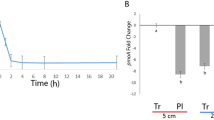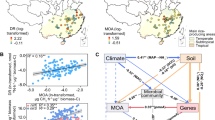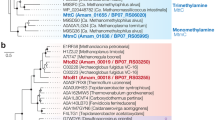Abstract
Methane (CH4) emissions from Arctic lakes are a large and growing source of greenhouse gas to the atmosphere with critical implications for global climate. Because Arctic lakes are ice covered for much of the year, understanding the metabolic flexibility of methanotrophs under anoxic conditions would aid in characterizing the mechanisms responsible for limiting CH4 emissions from high-latitude regions. Using sediments from an active CH4 seep in Lake Qalluuraq, Alaska, we conducted DNA-based stable isotope probing (SIP) in anoxic mesocosms and found that aerobic Gammaproteobacterial methanotrophs dominated in assimilating CH4. Aerobic methanotrophs were also detected down to 70 cm deep in sediments at the seep site, where anoxic conditions persist. Metagenomic analyses of the heavy DNA from 13CH4-SIP incubations showed that these aerobic methanotrophs had the capacity to generate intermediates such as methanol, formaldehyde, and formate from CH4 oxidation and to oxidize formaldehyde in the tetrahydromethanopterin (H4MPT)-dependent pathway under anoxic conditions. The high levels of Fe present in sediments, combined with Fe and CH4 profiles in the persistent CH4 seep site, suggested that oxidation of CH4, or, more specifically, its intermediates such as methanol and formaldehyde might be coupled to iron reduction. Aerobic methanotrophs also possessed genes associated with nitrogen and hydrogen metabolism, which might provide potentially alternative energy conservation options under anoxic conditions. These results expand the known metabolic spectrum of aerobic methanotrophs under anoxic conditions and necessitate the re-assessment of the mechanisms underlying CH4 oxidation in the Arctic, especially under lakes that experience extended O2 limitations during ice cover.
Similar content being viewed by others
Log in or create a free account to read this content
Gain free access to this article, as well as selected content from this journal and more on nature.com
or
References
Saunois M, Stavert AR, Poulter B, Bousquet P, Canadell JG, Jackson RB, et al. The global methane budget 2000-2017. Earth Syst Sci Data. 2020;12:1561–623.
Reeburgh WS. Oceanic methane biogeochemistry. Chem Rev. 2007;107:486–513.
Weber T, Wiseman NA, Kock A. Global ocean methane emissions dominated by shallow coastal waters. Nat Commun. 2019;10:4584.
He R, Wooller MJ, Pohlman JW, Quensen J, Tiedje JM, Leigh MB. Shifts in identity and activity of methanotrophs in arctic lake sediments in response to temperature changes. Appl Environ Microb. 2012;78:4715–23.
Phelps AR, Peterson KM, Jeffries MO. Methane efflux from high-latitude lakes during spring ice melt. J Geophys Res Atmos. 1998;103:29029–36.
Walter KM, Smith LC, Chapin FS. Methane bubbling from northern lakes: present and future contributions to the global methane budget. Philos Trans A Math Phys Eng Sci. 2007;365:1657–76.
Wik M, Varner RK, Anthony KW, MacIntyre S, Bastviken D. Climate-sensitive northern lakes and ponds are critical components of methane release. Nat Geosci. 2016;9:99–105.
Knittel K, Boetius A. Anaerobic oxidation of methane: progress with an unknown process. Annu Rev Microbiol. 2009;63:311–34.
Timmers PHA, Welte CU, Koehorst JJ, Plugge CM, Jetten MSM, Stams AJM. Reverse methanogenesis and respiration in methanotrophic archaea. Archaea. 2017;2017:1654237.
Shen LD, Ouyang L, Zhu Y, Trimmer M. Active pathways of anaerobic methane oxidation across contrasting riverbeds. ISME J. 2019;13:752–66.
Valenzuela EI, Cervantes FJ. The role of humic substances in mitigating greenhouse gases emissions: Current knowledge and research gaps. Sci Total Environ. 2021;750:141677.
Orphan VJ, House CH, Hinrichs KU, McKeegan KD, DeLong EF. Multiple archaeal groups mediate methane oxidation in anoxic cold seep sediments. Proc Natl Acad Sci USA. 2002;99:7663–8.
Orphan VJ, House CH, Hinrichs KU, McKeegan KD, DeLong EF. Methane-consuming archaea revealed by directly coupled isotopic and phylogenetic analysis. Science. 2001;293:484–7.
Haroon MF, Hu S, Shi Y, Imelfort M, Keller J, Hugenholtz P, et al. Anaerobic oxidation of methane coupled to nitrate reduction in a novel archaeal lineage. Nature. 2013;500:567–70.
Cai C, Leu AO, Xie GJ, Guo JH, Feng YX, Zhao JX, et al. A methanotrophic archaeon couples anaerobic oxidation of methane to Fe(III) reduction. ISME J. 2018;12:1929–39.
Ettwig KF, Zhu B, Speth D, Keltjens JT, Jetten MSM, Kartal B. Archaea catalyze iron-dependent anaerobic oxidation of methane. Proc Natl Acad Sci USA. 2016;113:12792–6.
Leu AO, Cai C, Mcllroy SJ, Southam G, Orphan VJ, Yuan ZG, et al. Anaerobic methane oxidation coupled to manganese reduction by members of the Methanoperedenaceae. ISME J. 2020;14:1030–41.
Ettwig KF, Butler MK, Le Paslier D, Pelletier E, Mangenot S, Kuypers MMM, et al. Nitrite-driven anaerobic methane oxidation by oxygenic bacteria. Nature. 2010;464:543–8.
Martinez-Cruz K, Leewis MC, Herriott IC, Sepulveda-Jauregui A, Anthony KW, Thalasso F, et al. Anaerobic oxidation of methane by aerobic methanotrophs in sub-Arctic lake sediments. Sci Total Environ. 2017;607:23–31.
He R, Wooller MJ, Pohlman JW, Quensen J, Tiedje JM, Leigh MB. Diversity of active aerobic methanotrophs along depth profiles of arctic and subarctic lake water column and sediments. ISME J. 2012;6:1937–48.
Bowman JP, Sly LI, Nichols PD, Hayward AC. Revised taxonomy of the methanotrophs: description of Methylobacter gen. nov., validation of Methylosinus and Methylocystis species, and a proposal that the family Methylococcaceae includes only the group I methanotrophs. Int J Syst Bacteriol. 1993;43:735–53.
Oswald K, Milucka J, Brand A, Hach P, Littmann S, Wehrli B, et al. Aerobic gammaproteobacterial methanotrophs mitigate methane emissions from oxic and anoxic lake waters. Limnol Oceanogr. 2016;61:S101–18.
Cabrol L, Thalasso F, Gandois L, Sepulveda-Jauregui A, Martinez-Cruz K, Teisserenc R, et al. Anaerobic oxidation of methane and associated microbiome in anoxic water of Northwestern Siberian lakes. Sci Total Environ. 2020;736:139588.
Milucka J, Kirf M, Lu L, Krupke A, Lam P, Littmann S, et al. Methane oxidation coupled to oxygenic photosynthesis in anoxic waters. ISME J. 2015;9:1991–2002.
Kalyuzhnaya MG, Yang S, Rozova ON, Smalley NE, Clubb J, Lamb A, et al. Highly efficient methane biocatalysis revealed in a methanotrophic bacterium. Nat Commun. 2013;4:2785.
Kits KD, Klotz MG, Stein LY. Methane oxidation coupled to nitrate reduction under hypoxia by the Gammaproteobacterium Methylomonas denitrificans, sp. nov. type strain FJG1. Environ Microbiol. 2015;17:3219–32.
Eberl DD. Quantitative mineralogy of the Yukon River system: variations with reach and season, and determining sediment provenance. Am Mineral. 2004;89:1784–94.
Lipson DA, Raab TK, Goria D, Zlamal J. The contribution of Fe(III) and humic acid reduction to ecosystem respiration in drained thaw lake basins of the Arctic Coastal Plain. Glob Biogeochem Cycles 2013;27:399–409.
Li WB, Yao J, Tao PP, Guo MT, Feng XY, He YN, et al. A comparative study on two extraction procedures in speciation of iron in municipal solid waste. J Hazard Mater. 2010;182:640–8.
Oremland RS, Taylor BF. Sulfate reduction and methanogenesis in marine sediments. Geochim Cosmochim Acta. 1978;42:209–14.
Glassburn CL, Potter BA, Clark JL, Reuther JD, Bruning DL, Wooller MJ. Strontium and oxygen isotope profiles of sequentially sampled modern bison (bison bison bison) teeth from interior Alaska as proxies of seasonal mobility. Arctic. 2018;71:183–200.
He R, Wooller MJ, Pohlman JW, Catranis C, Quensen J, Tiedje JM, et al. Identification of functionally active aerobic methanotrophs in sediments from an arctic lake using stable isotope probing. Environ Microbiol. 2012;14:1403–19.
Leigh MB, Pellizari VH, Uhlik O, Sutka R, Rodrigues J, Ostrom NE, et al. Biphenyl-utilizing bacteria and their functional genes in a pine root zone contaminated with polychlorinated biphenyls (PCBs). ISME J. 2007;1:134–48.
Swan BK, Ehrhardt CJ, Reifel KM, Moreno LI, Valentine DL. Archaeal and bacterial communities respond differently to environmental gradients in anoxic sediments of a California hypersaline lake, the salton sea. Appl Environ Microb. 2010;76:757–68.
Dedysh SN, Liesack W, Khmelenina VN, Suzina NE, Trotsenko YA, Semrau JD, et al. Methylocella palustris gen. nov., sp. nov., a new methane-oxidizing acidophilic bacterium from peat bogs, representing a novel subtype of serine-pathway methanotrophs. Int J Syst Evol Microbiol. 2000;50:955–69.
Vorobev AV, Baani M, Doronina NV, Brady AL, Liesack W, Dunfield PF, et al. Methyloferula stellata gen. nov. sp. nov. an acidophilic, obligately methanotrophic bacterium that possesses only a soluble methane monooxygenase. Int J Syst Evol Microbiol. 2011;61:2456–63.
Kolb S, Knief C, Stubner S, Conrad R. Quantitative detection of methanotrophs in soil by novel pmoA-targeted real-time PCR assays. Appl Environ Microbiol. 2003;69:2423–9.
Fierer N, Schimel JP, Holden PA. Influence of drying–rewetting frequency on soil bacterial community structure. Micro Ecol. 2003;45:63–71.
Fierer N, Jackson RB. The diversity and biogeography of soil bacterial communities. Proc Natl Acad Sci USA. 2006;103:626–31.
Huang XQ, Madan A. CAP3: a DNA sequence assembly program. Genome Res. 1999;9:868–77.
Ma RC, Chu YX, Wang J, Wang C, Leigh MB, Chen Y, et al. Stable-isotopic and metagenomic analyses reveal metabolic and microbial link of aerobic methane oxidation coupled to denitrification at different O2 levels. Sci Total Environ. 2020;764:142901.
Luo RB, Liu BH, Xie YL, Li ZY, Huang WH, Yuan JY, et al. SOAPdenovo2: an empirically improved memory-efficient short-read de novo assembler. GigaScience. 2012;1:18.
You MS, Yue Z, He WY, Yang XH, Yang G, Xie M, et al. A heterozygous moth genome provides insights into herbivory and detoxification. Nat Genet. 2013;45:220–5.
Zhu WH, Lomsadze A, Borodovsky M. Ab initio gene identification in metagenomic sequences. Nucleic Acids Res. 2010;38:e132.
Guo JH, Peng YZ, Fan L, Zhang L, Ni BJ, Kartal B, et al. Metagenomic analysis of anammox communities in three different microbial aggregates. Environ Microbiol. 2016;18:2979–93.
Li WZ, Godzik A. Cd-hit: a fast program for clustering and comparing large sets of protein or nucleotide sequences. Bioinformatics. 2006;22:1658–9.
Liu SP, Chen QL, Zou HJ, Yu YJ, Zhou ZL, Mao J, et al. A metagenomic analysis of the relationship between microorganisms and flavor development in Shaoxing mechanized huangjiu fermentation mashes. Int J Food Microbiol. 2019;303:9–18.
Francis OE, Bendall M, Manimaran S, Hong CJ, Clement NL, Castro-Nallar E, et al. Pathoscope: Species identification and strain attribution with unassembled sequencing data. Genome Res. 2013;23:1721–9.
He Y, Feng XY, Fang J, Zhang Y, Xiao X. Metagenome and metatranscriptome revealed a highly active and intensive sulfur cycle in an oil-immersed hydrothermal chimney in Guaymas basin. Front Microbiol. 2015;6:1236.
Schubert CJ, Vazquez F, Losekann-Behrens T, Knittel K, Tonolla M, Boetius A. Evidence for anaerobic oxidation of methane in sediments of a freshwater system (Lago di Cadagno). FEMS Microbiol Ecol. 2011;76:26–38.
He R, Wooller MJ, Pohlman JW, Tiedje JM, Leigh MB. Methane-derived carbon flow through microbial communities in arctic lake sediments. Environ Microbiol. 2015;17:3233–50.
Vorholt JA. Cofactor-dependent formaldehyde oxidation in methylotrophic bacteria. Arch Microbiol. 2002;178:239–49.
Garber AI, Nealson KH, Okamoto A, McAllister SM, Chan CS, Barco RA, et al. FeGenie: a comprehensive tool for the identification of iron genes and iron gene neighborhoods in genome and metagenome assemblies. Front Microbiol. 2020;11:37.
Barco A, Emerson D, Sylvan JB, Orcutt BN, Meyers MEJ, Ramírez GA, et al. New insight into microbial iron oxidation as revealed by the proteomic profile of an obligate iron-oxidizing chemolithoautotroph roman. Appl Environ Microbiol. 2015;81:5927–37.
De Beer D, Sauter E, Niemann H, Kaul N, Foucher JP, Witte U, et al. In situ fluxes and zonation of microbial activity in surface sediments of the Hakon Mosby Mud Volcano. Limnol Oceanogr. 2006;51:1315–31.
Lösekann T, Knittel K, Nadalig T, Fuchs B, Niemann H, Boetius A, et al. Diversity and abundance of aerobic and anaerobic methane oxidizers at the Haakon Mosby mud volcano, Barents Sea. Appl Environ Microb. 2007;73:3348–62.
Blees J, Niemann H, Wenk CB, Zopfi J, Schubert CJ, Kirf MK, et al. Micro-aerobic bacterial methane oxidation in the chemocline and anoxic water column of deep south-Alpine Lake Lugano (Switzerland). Limnol Oceanogr. 2014;59:311–24.
Reid T, Chaganti SR, Droppo IG, Weisener CG. Novel insights into freshwater hydrocarbon-rich sediments using metatranscriptomics: opening the black box. Water Res. 2018;136:1–11.
Weber KA, Achenbach LA, Coates JD. Microorganisms pumping iron: anaerobic microbial iron oxidation and reduction. Nat Rev Microbiol. 2006;4:752–64.
Ward N, Larsen Ø, Sakwa J, Bruseth L, Khouri H, Durkin AS, et al. Genomic insights into methanotrophy: the complete genome sequence of Methylococcus capsulatus (Bath). PLoS Biol. 2004;2:1616–28.
Versantvoort W, Pol A, Jetten MSM, van Niftrik L, Reimann J, Kartal B, et al. Multiheme hydroxylamine oxidoreductases produce NO during ammonia oxidation in methanotrophs. Prot Natl Acad Sci USA. 2020;117:24459–63.
Richardson DJ, Berks BC, Russell DA, Spiro S, Taylor CJ. Functional, biochemical and genetic diversity of prokaryotic nitrate reductases. Cell Mol Life Sci. 2001;58:165–78.
Carere CR, McDonald B, Peach HA, Greening C, Gapes DJ, Collet C, et al. Hydrogen oxidation influences glycogen accumulation in a verrucomicrobial methanotroph. Front Microbiol. 2019;10:1873.
Hanczár T, Csáki R, Bodrossy L, Murrell JC, Kovács KL. Detection and localization of two hydrogenases in Methylococcus capsulatus (Bath) and their potential role in methane metabolism. Arch Microbiol. 2002;177:167–72.
Shah NN, Hanna ML, Jackson KJ, Taylor RT. Batch cultivation of Methylosinus trichosporium OB3b. 4: production of hydrogen-driven soluble or particulate methane monooxygenase activity. Biotechnol Bioeng. 1995;45:229–38.
Mohammadi S, Pol A, van Alen TA, Jetten MSM, Op den Camp HJM. Methylacidiphilum fumariolicum SolV, a thermoacidophilic ‘Knallgas’ methanotroph with both an oxygen-sensitive and -insensitive hydrogenase. ISME J. 2017;11:945–58.
Carere CR, Hards K, Houghton KM, Power JF, McDonald B, Collet C, et al. Mixotrophy drives niche expansion of Verrucomicrobial methanotrophs. ISME J. 2017;11:2599–610.
Orata FD, Meier-Kolthoff JP, Sauvageau D, Stein LY. Phylogenomic analysis of the Gammaproteobacterial methanotrophs (Order Methylococcales) calls for the reclassification of members at the genus and species levels. Front Microbiol. 2018;9:3162.
Kucera J, Sedo O, Potesil D, Janiczek O, Zdrahal Z, Mandl M. Comparative proteomic analysis of sulfur-oxidizing Acidithiobacillus ferrooxidans CCM 4253 cultures having lost the ability to couple anaerobic elemental sulfur oxidation with ferric iron reduction. Res Microbiol. 2016;167:587–94.
Kucera J, Zeman J, Mandl M, Cerna H. Stoichiometry of bacterial anaerobic oxidation of elemental sulfur by ferric iron. Antonie van Leeuwenhoek. 2012;101:919–22.
He QX, Yu LP, Li JB, He D, Cai XX, Zhou SG. Electron shuttles enhance anaerobic oxidation of methane coupled to iron (III) reduction. Sci Total Environ. 2019;688:664–72.
Jing XX, Wu YC, Shi L, Peacock CL, Ashry NM, Gao CH, et al. Outer membrane c-type cytochromes OmcA and MtrC play distinct roles in enhancing the attachment of Shewanella oneidensis MR-1 cells to goethite. Appl Environ Microbiol. 2020;86:e01941–20.
Tanaka K, Vokoe S, Igarashi K, Takashino M, Ishikawa M, Hori K, et al. Extracellular electron transfer via outer membrane cytochromes in a methanotrophic bacterium Methylococcus capsulatus (Bath). Front Microbiol. 2018;9:2905.
Kamalanathan M, Dao LHT, Chaisutyakorna P, Gleadow R, Beardall J. Photosynthetic physiology of Scenedesmus sp (Chlorophyceae) under photoautotrophic and molasses-based heterotrophic and mixotrophic conditions. Phycologia. 2017;56:666–74.
Qu LR, Wang C, Bai E. Evaluation of the 18O-H2O incubation method for measurement of soil microbial carbon use efficiency. Soil Biol Biochem. 2020;145:107802.
Kapiluto Y, Yakir D, Tans P, Berkowitz B. Experimental and numerical studies of the 18O exchange between CO2 and water in the atmosphere–soil invasion flux. Geochim Cosmochim Acta. 2007;71:2657–71.
Zeebe RE. Kinetic fractionation of carbon and oxygen isotopes during hydration of carbon dioxide. Geochim Cosmochim Acta. 2014;139:540–52.
Acknowledgements
This work was conducted under BLM permit (FF095556), and North Slope Borough permits (NSB 09-0478 and NSB 10-018). Any use of trade, firm, or product names is for descriptive purposes only and does not imply endorsement by the U.S. Government. This work was supported by funding from United States Department of Energy National Energy Technology Laboratory (Grant DE-NT000565) and National Natural Science Foundation of China with Grants No. 91851109 and 41671245 and Natural Science Foundation of Zhejiang province with Grant No. LZ20E080002. Support for the UAF molecular instrumentation in the Institute of Arctic Biology Genomics Core Laboratory was provided by an Institutional Development Award (IDeA) from the National Institute of General Medical Sciences of the National Institutes of Health under grant number 2P20GM103395. The findings and conclusions in this article are those of the authors and do not necessarily reflect the official views of the NIH.
Author information
Authors and Affiliations
Corresponding authors
Ethics declarations
Competing interests
The authors declare no competing interests.
Additional information
Publisher’s note Springer Nature remains neutral with regard to jurisdictional claims in published maps and institutional affiliations.
Supplementary information
Rights and permissions
About this article
Cite this article
He, R., Wang, J., Pohlman, J.W. et al. Metabolic flexibility of aerobic methanotrophs under anoxic conditions in Arctic lake sediments. ISME J 16, 78–90 (2022). https://doi.org/10.1038/s41396-021-01049-y
Received:
Revised:
Accepted:
Published:
Issue date:
DOI: https://doi.org/10.1038/s41396-021-01049-y
This article is cited by
-
Reduction of enteric methane emission using methanotroph-based probiotics in Hanwoo steers
Animal Microbiome (2025)
-
Assessment of three prokaryote primers for concurrent and comprehensive profiling of methanogen and methanotroph community and habitat specificity in three distinct wetland sediments
Journal of Soils and Sediments (2025)
-
Survival strategies of aerobic methanotrophs under hypoxia in methanogenic lake sediments
Environmental Microbiome (2024)
-
Metabolic coupling between soil aerobic methanotrophs and denitrifiers in rice paddy fields
Nature Communications (2024)
-
Higher diversity of sulfur-oxidizing bacteria based on soxB gene sequencing in surface water than in spring in Wudalianchi volcanic group, NE China
International Microbiology (2024)



